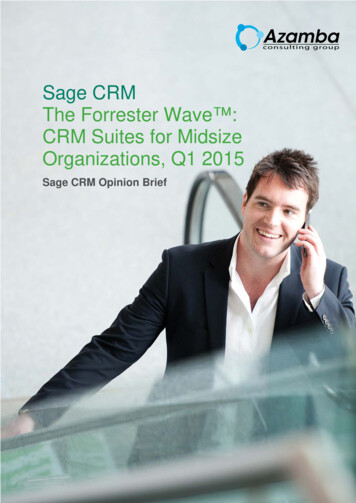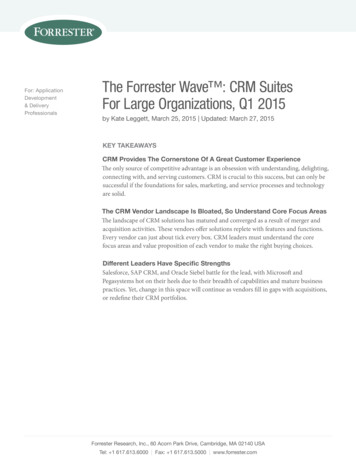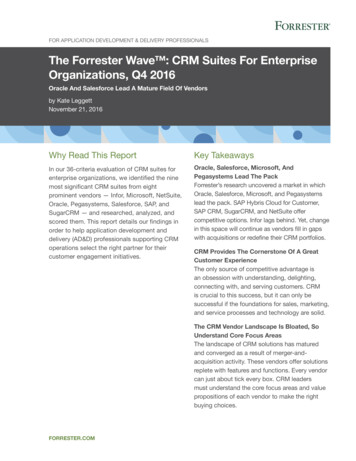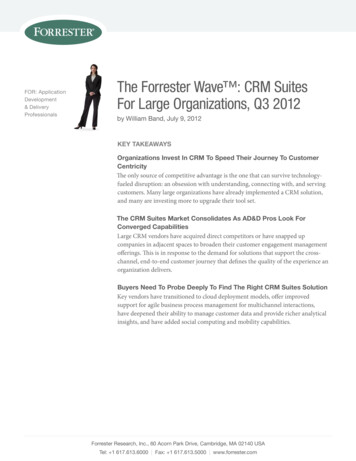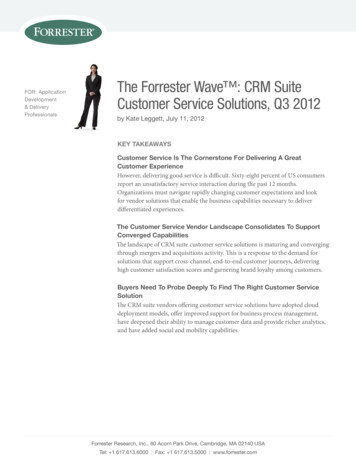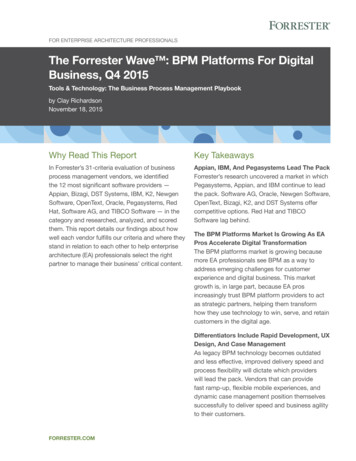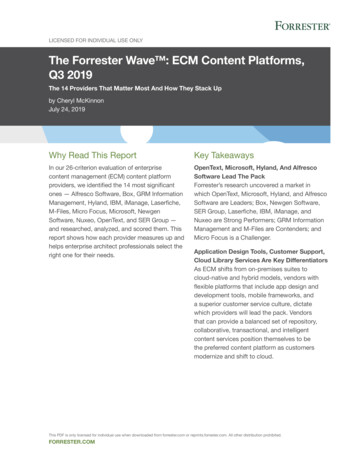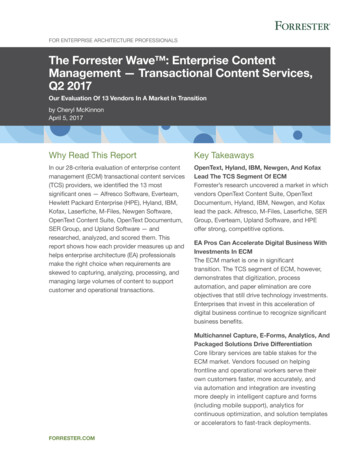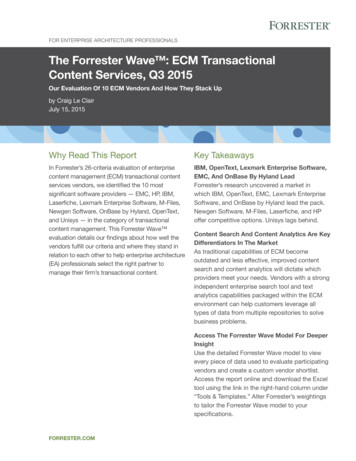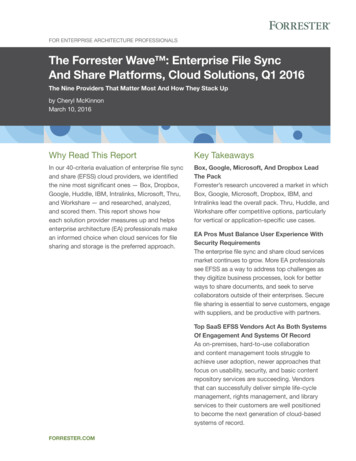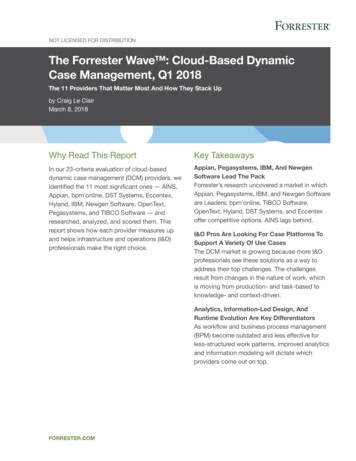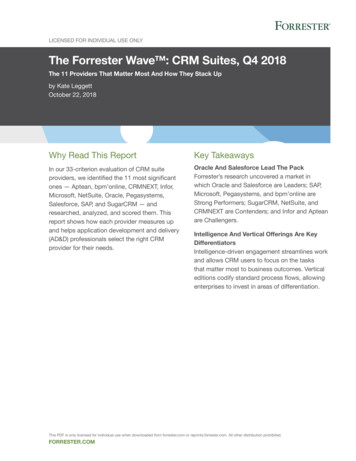
Transcription
LICENSED FOR INDIVIDUAL USE ONLYThe Forrester Wave : CRM Suites, Q4 2018The 11 Providers That Matter Most And How They Stack Upby Kate LeggettOctober 22, 2018Why Read This ReportKey TakeawaysIn our 33-criterion evaluation of CRM suiteproviders, we identified the 11 most significantones — Aptean, bpm’online, CRMNEXT, Infor,Microsoft, NetSuite, Oracle, Pegasystems,Salesforce, SAP, and SugarCRM — andresearched, analyzed, and scored them. Thisreport shows how each provider measures upand helps application development and delivery(AD&D) professionals select the right CRMprovider for their needs.Oracle And Salesforce Lead The PackForrester’s research uncovered a market inwhich Oracle and Salesforce are Leaders; SAP,Microsoft, Pegasystems, and bpm’online areStrong Performers; SugarCRM, NetSuite, andCRMNEXT are Contenders; and Infor and Apteanare Challengers.Intelligence And Vertical Offerings Are KeyDifferentiatorsIntelligence-driven engagement streamlines workand allows CRM users to focus on the tasksthat matter most to business outcomes. Verticaleditions codify standard process flows, allowingenterprises to invest in areas of differentiation.This PDF is only licensed for individual use when downloaded from forrester.com or reprints.forrester.com. All other distribution prohibited.FORRESTER.COM
FOR APPLICATION DEVELOPMENT & DELIVERY PROFESSIONALSThe Forrester Wave : CRM Suites, Q4 2018The 11 Providers That Matter Most And How They Stack Upby Kate Leggettwith Daniel Hong, John Bruno, Lori Wizdo, Liz Herbert, Sarah Dawson, and Peter HarrisonOctober 22, 2018Table Of ContentsRelated Research Documents2 Modern CRM Is At The Heart Of The Age OfThe CustomerFive Key CRM Trends For 2018 That Shape HowCompanies Drive Relationship And Revenue3 Evaluation SummaryThe Forrester Wave : CRM Suites For EnterpriseOrganizations, Q4 20166 Vendor OfferingsTransform Customer Processes And Systems ToImprove Experiences6 Vendor ProfilesLeadersStrong PerformersContendersChallengers13 Evaluation OverviewShare reports with colleagues.Enhance your membership withResearch Share.Vendor Inclusion Criteria14 Supplemental MaterialForrester Research, Inc., 60 Acorn Park Drive, Cambridge, MA 02140 USA 1 617-613-6000 Fax: 1 617-613-5000 forrester.com 2018 Forrester Research, Inc. Opinions reflect judgment at the time and are subject to change. Forrester ,Technographics , Forrester Wave, TechRadar, and Total Economic Impact are trademarks of Forrester Research,Inc. All other trademarks are the property of their respective companies. Unauthorized copying or distributingis a violation of copyright law. Citations@forrester.com or 1 866-367-7378
FOR APPLICATION DEVELOPMENT & DELIVERY PROFESSIONALSOctober 22, 2018The Forrester Wave : CRM Suites, Q4 2018The 11 Providers That Matter Most And How They Stack UpModern CRM Is At The Heart Of The Age Of The CustomerForrester defines CRM as:The business processes and supporting technologies that support the key activities of targeting,acquiring, retaining, understanding, and collaborating with customers.Improvements to operational efficiencies have been the key benefit of CRM and are easy to quantify.This has led AD&D pros to widely deploy CRM in organizations of all sizes — large and small. However,gains in operational efficiencies have become table stakes. The value of CRM has shifted towardhelping organizations better support customers in their end-to-end engagement journeys to garnertheir satisfaction and long-term loyalty — an outside-in perspective.Modern CRM strategies enable differentiated customer experiences. They support customerinteractions over a range of channels and touchpoints. How? By leveraging vast amounts ofinteraction, behavioral, and transaction data to enable contextual experiences that deliver value to thecustomer and preserve the value of the company brand. Modern CRM has evolved along the followingdimensions to deliver differentiated experiences, and companies should look for providers that:›› Support select business models and organizational sizes. The CRM needs of a B2B companyare different than those of a B2C company — and of a midsize company compared with anenterprise. For example, B2B companies with complex, long-running sales and service cyclesrequire more complex process management for quote-to-order and renewals than B2C companieswhere eCommerce may be the primary sales channel. CRM vendors are now much better ataccommodating the right size and complexity of organization based on the inherent strengths oftheir feature sets.›› Operationalize intelligence to impact outcomes. Enterprises that manage huge volumes ofdata struggle to pinpoint optimal offers, discount levels, product bundles, or the right contentor knowledge for an interaction. They have difficulty focusing customer-facing employees onthe tasks that matter most to the business. CRM vendors now offer comprehensive intelligencestrategies to uncover insight and prescribe the right action for the business user to take incustomer-facing interactions.›› Offer vertical editions. Horizontal CRM can only take you so far, as different industries havedifferent requirements and lexicons for engaging with customers. CRM vendors increasingly offereditions — templates, common process flows, data model extensions, and UI labels — pertinent tospecific industries as well as personnel with deep domain expertise.›› Expose platform services. Silos of data and processes within enterprises emerge as enterprisespurchase CRM not as a unified suite but as discrete sales, marketing, customer service, andeCommerce applications. As a result, platforms that unify data, processes, and security within variousenterprise CRM deployments are rising in importance. Platforms also allow developers or businessanalysts using low-code tooling to create applications that extend capabilities within packaged CRM. 2018 Forrester Research, Inc. Unauthorized copying or distributing is a violation of copyright law.Citations@forrester.com or 1 866-367-73782
FOR APPLICATION DEVELOPMENT & DELIVERY PROFESSIONALSOctober 22, 2018The Forrester Wave : CRM Suites, Q4 2018The 11 Providers That Matter Most And How They Stack Up›› Invest in ecosystems of value. CRM users on the frontlines can’t serve modern customers usingonly core CRM. They struggle with duplicate work or manual call wrap-up procedures, whichdecrease their productivity and limit their effectiveness. Today, CRM vendors have invested inapplication exchanges. These application exchanges contain an ecosystem of point solutions suchas eSignature capture, automated data capture, dialers, and schedulers — to name a few — thatextend and enhance the power of core CRM. CRM vendors invest in and curate these applicationexchanges to varying degrees.›› Enhance client relationships through partners and customer success programs. In a maturemarket, you have to dig deep to find real differences between vendor offerings. CRM successdepends on the right choice of consulting partners to implement and integrate your solution. Lookfor CRM vendors that have mature consulting services, regional and global strategic servicespartners, and investments in customer success to properly onboard customers and activelymanage customer relationships.Evaluation SummaryOur Forrester Wave evaluation highlights the fact that even though core CRM capabilities are mature,CRM vendor suites are still evolving. Technologies such as AI are introducing new efficiencies intoCRM processes, and acquisitions such as configure-price-quote (CPQ) and eCommerce are expandingthe footprint of CRM.This evaluation found that vendors fall into two distinct categories: Vendors such as Oracle, Salesforce,and SAP have best-of-breed, discrete applications suitable for enterprise deployments; havecomposed their CRM suites via acquisition; and are now dedicated to unifying these acquisitions.Vendors such as bpm’online, Microsoft, NetSuite, and SugarCRM have streamlined capabilities moresuitable for midsize organizations and offer CRM capabilities on a unified platform. However, in allcases, the focus on supporting end-to-end business transformation — that crosses the front, mid, andback office — becomes top of mind for all vendors. Some offer full front- and back-office businesssuites, which include CRM; others offer industry editions; and yet others offer packaged adapters andintegration frameworks to back-office applications.We intend this evaluation of the CRM suites market to be a starting point only and encourage clients toview detailed product evaluations and adapt criteria weightings to fit their individual needs through theExcel-based vendor comparison tool (see Figure 1 and see Figure 2). Click the link at the beginning ofthis report on Forrester.com to download the tool. 2018 Forrester Research, Inc. Unauthorized copying or distributing is a violation of copyright law.Citations@forrester.com or 1 866-367-73783
FOR APPLICATION DEVELOPMENT & DELIVERY PROFESSIONALSOctober 22, 2018The Forrester Wave : CRM Suites, Q4 2018The 11 Providers That Matter Most And How They Stack UpFIGURE 1 Forrester Wave : CRM Suites, Q4 2018CRM SuitesQ4 ApteanWeakercurrentofferingWeaker strategyStronger strategyMarket presence**A gray marker indicates incomplete vendor participation. 2018 Forrester Research, Inc. Unauthorized copying or distributing is a violation of copyright law.Citations@forrester.com or 1 866-367-73784
FOR APPLICATION DEVELOPMENT & DELIVERY PROFESSIONALSOctober 22, 2018The Forrester Wave : CRM Suites, Q4 2018The 11 Providers That Matter Most And How They Stack UpForw resei tegh r’stingApteabp n*m’onCRM lineNEInfo XT*rMicroN sofettSuO iteraclePegasSa ystemlessSA forcePSugarCRMFIGURE 2 Forrester Wave : CRM Suites Scorecard, Q4 2018Current offering50%1.05 2.51 1.89 1.83 3.47 1.96 4.37 3.35 4.16 3.81 2.06Sales force automation (SFA)10%1.00 3.00 3.00 1.00 5.00 1.00 5.00 3.00 5.00 3.00 3.00Configure price quote (CPQ)5%0.00 1.00 3.00 3.00 1.00 1.00 5.00 1.00 3.00 5.00 1.00Marketing automation15%1.00 2.00 2.00 2.00 1.00 1.00 5.00 3.00 5.00 3.00 1.00Customer service15%1.00 3.00 1.00 1.00 5.00 1.00 5.00 5.00 5.00 3.00 3.00Field service10%1.00 3.00 1.00 3.00 5.00 1.00 5.00 3.00 5.00 5.00 1.00Commerce10%0.00 0.00 0.00 1.00 0.50 3.00 3.00 0.00 4.00 5.00 0.00Business intelligence15%1.00 2.00 2.00 2.00 5.00 2.00 4.00 4.00 4.00 4.00 2.00Portfolio cohesion and consistency15%2.30 4.40 2.90 2.50 3.80 4.40 3.10 4.30 1.70 3.40 4.405%1.00 3.00 3.00 1.00 3.00 3.00 5.00 5.00 5.00 5.00 1.00Strategy50%1.20 3.13 2.46 1.13 3.31 2.55 3.98 2.63 4.16 3.01 2.89Product strategy35%1.00 3.00 3.00 1.00 3.00 1.00 5.00 3.00 5.00 3.00 3.00Go-to-market approach15%1.40 2.50 2.30 1.00 3.20 3.60 4.30 2.80 2.70 3.70 2.50Supporting services20%2.00 3.00 3.00 1.00 3.00 5.00 3.00 2.00 4.00 3.00 3.00Delivery and extensibility ecosystem 20%0.45 3.00 1.55 1.90 3.90 2.30 3.90 2.30 5.00 3.00 2.30Pricing and commercial terms10%1.50 5.00 1.50 0.50 4.00 2.00 2.00 3.00 2.00 2.00 4.000%1.00 1.00 2.00 1.00 5.00 2.00 4.00 2.00 5.00 3.00 2.00100%1.00 1.00 2.00 1.00 5.00 2.00 4.00 2.00 5.00 3.00 2.00Customer journey supportMarket presenceInstalled baseAll scores are based on a scale of 0 (weak) to 5 (strong).*Indicates a nonparticipating vendor. 2018 Forrester Research, Inc. Unauthorized copying or distributing is a violation of copyright law.Citations@forrester.com or 1 866-367-73785
FOR APPLICATION DEVELOPMENT & DELIVERY PROFESSIONALSOctober 22, 2018The Forrester Wave : CRM Suites, Q4 2018The 11 Providers That Matter Most And How They Stack UpVendor OfferingsForrester included 11 vendors in this assessment: Aptean, bpm’online, CRMNEXT, Infor, Microsoft,NetSuite, Oracle, Pegasystems, Salesforce, SAP, and SugarCRM (see Figure 3).FIGURE 3 Evaluated Vendors And Product InformationVendorProduct suiteProduct versionApteanAptean Pivotal CRMN/Abpm’onlinebpm’online CRM7.12CRMNEXTCRMNEXTN/AInforInfor CRM8.4MicrosoftMicrosoft Dynamics 365N/ANetSuiteNetSuite CRM2018.1OracleOracle CX er 2018 releaseSAPSAP C/4HANA1805SugarCRMSugarSummer 2018 8.2Vendor ProfilesOur analysis uncovered the following strengths and weaknesses of individual vendors.Leaders›› Oracle delivers business transformation beyond the front office. Oracle’s far-reaching vision isto enable the connected digital enterprise by integrating data, intelligence, and experiences acrossB2B and B2C customer journeys that span the front and back office. Oracle CX Cloud is part ofOracle’s larger software-as-a-service business suite that includes enterprise resource planning(ERP), supply chain management, and HR solutions. In addition, Oracle positions individualsolutions within CX Cloud for B2B and B2C scenarios. Its road map introduces new clouds (for 2018 Forrester Research, Inc. Unauthorized copying or distributing is a violation of copyright law.Citations@forrester.com or 1 866-367-73786
FOR APPLICATION DEVELOPMENT & DELIVERY PROFESSIONALSOctober 22, 2018The Forrester Wave : CRM Suites, Q4 2018The 11 Providers That Matter Most And How They Stack Upexample, a subscription management cloud), deepening capabilities within those new clouds, andintelligence infused across the CX suite. Although each product has thousands of customers, justover 600 of those customers own three or more products that are integrated together.Oracle delivers leading sales, marketing, customer service, and field service capabilities; however, itsB2B and B2C Commerce Cloud lags behind. Customer references indicated that there is too muchcomplexity in CX Cloud products, making them hard to learn. Oracle is dedicated to making its suitemore than the sum of its parts, many of which it acquired. For example, the new Engagement Cloudoffers sales and service capabilities on a single platform. Oracle has six packaged industry solutionsthat span front- and back-office functionality — and 12 lighter-weight ones. It has mature consultingservices aimed at modernizing implementations, including quick-start packages.Oracle CX Cloud is a good fit for B2B and B2C enterprises that are undergoing a businesstransformation and require the advanced capabilities of individual clouds.›› Salesforce lays a foundation for smarter engagement on a broader scale. In keeping withForrester’s age-of-the-customer theme, Salesforce puts the customer at the center of its vision,where its products connect customers and companies to enable success. It urges companiesto think about the “art of the possible.” This, in combination with its vast application ecosystem(AppExchange), its low-code platform, and its approach to interactive learning (Trailhead), hasallowed it to penetrate an installed base of more than 150,000 customers both large and small.Customers like Salesforce. A third of its customer base use more than one CRM product. Its roadmap is deeply focused on increasing user productivity, making AI consumable within its products,and broadening its portfolio. It recently acquired a B2B commerce solution (CloudCraze) and anintegration framework (MuleSoft), which has special appeal to the enterprise.Salesforce’s strength is in its broad end-to-end portfolio that caters to both B2C and B2Borganizations. However, it especially excels in B2C marketing and commerce compared with its B2Bproduct counterparts. Salesforce has done well at operationalizing intelligence scenarios across thesuite so that users can quantify results. The vendor offers six industry-specific solutions (financialservices, healthcare, government, education, nonprofit, and philanthropy). Weaknesses includeSalesforce’s current product integrations and tooling consistency, which are fragmented as a resultof its myriad acquisitions. Customers also find Salesforce expensive and cite account managementstruggles, which Salesforce is addressing by revamping its customer success processes.Salesforce best suits enterprises looking for a vendor to help actualize a front-office businesstransformation. 2018 Forrester Research, Inc. Unauthorized copying or distributing is a violation of copyright law.Citations@forrester.com or 1 866-367-73787
FOR APPLICATION DEVELOPMENT & DELIVERY PROFESSIONALSOctober 22, 2018The Forrester Wave : CRM Suites, Q4 2018The 11 Providers That Matter Most And How They Stack UpStrong Performers›› SAP takes a renewed interest in CRM and uses acquisitions to fill portfolio gaps. Recently,SAP rebranded its cloud CRM suite to C/4HANA, which consists of the SAP Marketing Cloud,Commerce Cloud, Service Cloud (which includes products from the Coresystems acquisition),Customer Data Cloud (which includes products from the Gigya acquisition), and Sales Cloud(which includes products from the CallidusCloud acquisition). SAP’s vision for its CRM suite is tohave a single data model, to adopt the SAP Fiori user experience across all products, and to useSAP Leonardo for AI-driven scenarios. SAP’s suite has a sound vision, but its CRM suite is a workin progress with a two-plus-year horizon for actualization. Its road map is focused on executing thisvision and rationalizing recent acquisitions.The natively developed sales and service clouds offer core capabilities, while the best-in-classcommerce, CPQ, and field service products that it acquired shine. SAP has a nascent applicationmarketplace and a smaller, but growing, developer ecosystem compared with others we evaluatedin this Forrester Wave. In addition, customers found issues with the variability of accountmanagement, implementation, and finding trained resources on the suite. SAP has invested heavilyin building out vertical functionality and making product acquisitions that appeal to retail, financialservices, telecommunications, and utilities customers.SAP C/4HANA is best suited for companies that are committed to SAP in the back office and arelooking for a front-office CRM solution to provide differentiated end-to-end engagement.›› Microsoft democratizes CRM for employees but lacks commerce capabilities. At the coreof Microsoft’s Dynamics 365 are a common data model and platform for office productivityapplications; front-office CRM applications, which include project management and talentmanagement; and back-office applications (finance, operations, and asset management).Microsoft’s “digital feedback loop” vision is to bridge the gap between historically separatefront and back offices as well as people, partners, and customers. Its road map is grounded inthree themes: investing in core capabilities, integrating with other Microsoft applications such asLinkedIn and Bing, and infusing intelligence in all products. This is a compelling vision and, coupledwith the attractive price point, contributes to its growing market presence.Microsoft Dynamics 365 provides strong across-the-board sales, customer service, andfield service with embedded intelligence that customers rated highly. This drives prescriptiveadvice scenarios to help optimize sales outcomes, monitor customer health, make contextualrecommendations, and provide predictive service. Its nascent B2B marketing capabilities, whereit relies on its Adobe partnership for more advanced scenarios, are a weakness. It also lacks anative CPQ engine and only has eCommerce capabilities for retail. Microsoft offers more than 30lighter-weight industry templates that complement those available from its broad partner network.Customers were positive on Microsoft’s onboarding and customer success programs as well as itstooling geared toward streamlining implementation. 2018 Forrester Research, Inc. Unauthorized copying or distributing is a violation of copyright law.Citations@forrester.com or 1 866-367-73788
FOR APPLICATION DEVELOPMENT & DELIVERY PROFESSIONALSOctober 22, 2018The Forrester Wave : CRM Suites, Q4 2018The 11 Providers That
The Forrester Wave : CRM Suites, Q4 2018 October 22, 2018 2018 Forrester Research, Inc. Unauthorized copying or distributing is a violation of copyright law. Citationsforrester.com or 1 866-367-7378 2 The 11 Providers That Matter Most And How They Stack Up Modern CRM Is At The H
